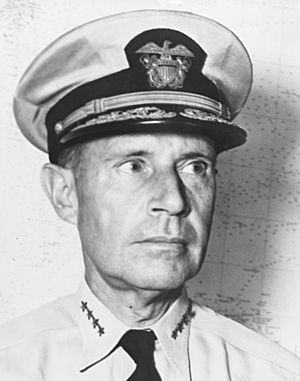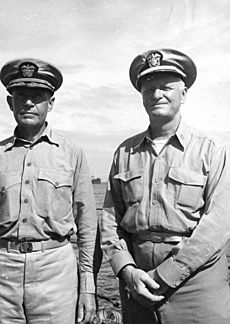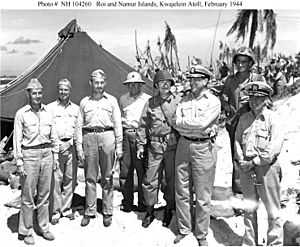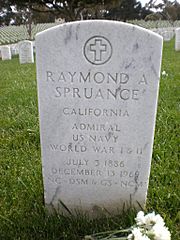Raymond A. Spruance facts for kids
Quick facts for kids
Raymond A. Spruance
|
|
|---|---|

Spruance in April 1944
|
|
| Nickname(s) | "Electric Brain" "Quiet Warrior" |
| Born | July 3, 1886 Baltimore, Maryland, US |
| Died | December 13, 1969 (aged 83) Pebble Beach, California, US |
| Buried |
Golden Gate National Cemetery, San Bruno, California
(section C-1,3) |
| Allegiance | |
| Service/ |
|
| Years of service | 1907–1948 |
| Rank | |
| Commands held | United States Fifth Fleet United States Pacific Fleet |
| Battles/wars |
|
| Awards |
|
| Other work | Ambassador to the Philippines |
Raymond Ames Spruance (born July 3, 1886 – died December 13, 1969) was a skilled United States Navy admiral during World War II. He was a key leader in some of the most important naval battles in the Pacific Ocean. These included the Battle of the Philippine Sea and the Battle of Midway. At Midway, his forces helped sink four large Japanese aircraft carriers. Many historians believe this battle was a major turning point in the war.
Admiral Spruance was known for staying calm even in very difficult situations. This earned him the nickname "Electric Brain." After the war, he became the President of the Naval War College. Later, he served as the American ambassador to the Philippines.
Contents
Early Life and Education
Raymond Spruance was born in Baltimore, Maryland, on July 3, 1886. He grew up in Indianapolis, Indiana. He went to public schools there and graduated from Shortridge High School.
After high school, he joined the U.S. Naval Academy and graduated in 1906. He also studied electrical engineering later on.
Spruance's first assignment was on the battleship USS Iowa. In 1907, he joined the battleship Minnesota. He sailed on this ship during the famous "Great White Fleet" cruise around the world from 1907 to 1909.
He later commanded several destroyers, including Bainbridge and Osborne. He also commanded the battleship Mississippi.
During World War I, he worked at the New York Naval Shipyard. He also had temporary duties in London and Edinburgh.
After the war, he commanded the destroyer USS Aaron Ward. He then commanded the newly built destroyer USS Percival in San Francisco, California.
From 1926 to 1927, he attended the Naval War College. He later became an instructor there from 1935 to 1938. In 1939, he was promoted to rear admiral.
World War II Service
Leading Up to Midway
At the start of World War II in the Pacific, Admiral Spruance commanded Cruiser Division Five. This group included four heavy cruisers. His division was part of a larger force led by Vice Admiral William F. Halsey, Jr.. This force carried out quick attacks against Japanese bases. These raids helped boost American morale and gave U.S. Navy sailors valuable experience.
The Battle of Midway

In May 1942, U.S. intelligence learned that Japan planned to attack Midway Island. The Japanese commander, Admiral Isoroku Yamamoto, wanted to expand Japan's defenses. He also hoped to force the U.S. to seek peace by threatening Hawaii and Pearl Harbor. However, Admiral Chester Nimitz, commander of the U.S. Pacific Fleet, knew he had to stop the Japanese. He needed to attack their aircraft carriers before they could strike Midway.
Just before the battle, Admiral Halsey became ill. He recommended Admiral Spruance to take his place. Spruance had not led carrier battles before. Halsey told him to trust his experienced staff, especially Captain Miles Browning. Spruance took command of Task Force 16, which included the carriers USS Enterprise and USS Hornet. Admiral Frank Jack Fletcher was in overall command of the U.S. forces. Fletcher's flagship, USS Yorktown, had been damaged in an earlier battle. But it was quickly repaired to join the Midway operation.
The U.S. Navy had three carriers: Enterprise, Hornet, and Yorktown. They faced a large Japanese invasion fleet. This fleet included four aircraft carriers led by Admiral Chūichi Nagumo.
On the morning of June 4, a U.S. scout plane spotted the Japanese carriers. Admiral Fletcher ordered Spruance to launch an attack with Enterprise and Hornet. He kept Yorktown in reserve. Spruance decided to launch his planes quickly. He wanted to catch the Japanese carriers while their planes were landing or preparing for the next wave. This would make the Japanese ships very vulnerable. He also ordered his squadrons to fly directly to their targets without waiting to form up. This was a risk, but it paid off.
The battle began. Early U.S. attacks faced heavy resistance. Then, U.S. dive bombers from Spruance's Enterprise found Nagumo's four carriers. The Japanese carriers had no air cover. Most of their planes were on the decks, refueling or rearming. Enterprise dive bombers badly damaged two Japanese carriers, including Nagumo's flagship Akagi. The Yorktown air group then crippled the Soryu. All three were later sunk.
The last Japanese carrier, Hiryū, launched attacks that damaged Yorktown again. But later, a U.S. scout plane found Hiryū. Fletcher ordered dive bombers to attack, which fatally damaged the fourth Japanese carrier. It was sunk the next day. However, a second strike from Hiryū badly damaged Fletcher's flagship, Yorktown. Fletcher then passed command to Spruance, who finished the battle.
The U.S. Navy sank all four Japanese carriers while losing only one, Yorktown. This victory at Midway was a huge turning point. It helped the U.S. gain an equal footing in the naval air war. Naval historian Samuel Eliot Morison praised Spruance's actions as "superb." He said Spruance was calm, decisive, and bold. For his leadership at Midway, Admiral Spruance received the Navy Distinguished Service Medal.
Midway gave the U.S. Navy confidence. It also bought time for American factories to produce more ships, planes, and weapons. This industrial power eventually helped the U.S. win the war.
Leading the Fifth Fleet

After Midway, Spruance became Admiral Nimitz's chief of staff. In September 1942, he was made Deputy Commander in Chief of the Pacific Fleet.
In August 1943, Spruance took command of the Central Pacific Force. This force was renamed the Fifth Fleet in April 1944. Admiral Nimitz had a unique system. Command of the main fleet switched between Admiral William Halsey Jr. (who called it the Third Fleet) and Admiral Spruance (who called it the Fifth Fleet). When not leading the fleet, the admirals planned future operations from Pearl Harbor.
Halsey and Spruance had different styles. Halsey was aggressive and took risks. Spruance was careful and planned everything. Despite their differences, they were good friends. Spruance was also good at working with difficult people.
Many sailors admired Halsey, but higher-ranking officers often preferred Spruance. Captain George C. Dyer said that Spruance was "an Admiral's admiral." This meant other admirals respected his calm and smart leadership.
In February 1944, Spruance led Operation Hailstone against the Japanese base at Truk. His forces destroyed many Japanese warships, merchant ships, and aircraft. Spruance himself led a group of battleships and cruisers that chased and sank fleeing Japanese ships. This was unusual for a four-star admiral to be so directly involved in a sea battle.
Battle of the Philippine Sea

In June 1944, Spruance's fleet protected the American invasion of Saipan. During this time, he defeated the Japanese fleet in the Battle of the Philippine Sea. His forces sank three Japanese carriers and destroyed about 600 enemy planes. This battle severely weakened Japan's naval air power.
Some people criticized Spruance for not being aggressive enough in chasing the remaining Japanese ships. However, his actions were praised and understood by his commanders, including Admiral Nimitz.
End of the Pacific War
For much of the war, Spruance used the heavy cruiser USS Indianapolis as his flagship. Later, he moved his flag to the battleship USS New Mexico. When New Mexico was hit by two Kamikaze planes off Okinawa, Spruance was seen helping to fight fires. He kept the ship as his flagship because it could still operate. He later chose the battleship USS New Jersey as his flagship. This large ship had plenty of room for his staff and could keep up with the fast carrier forces.
Spruance received the Navy Cross for his actions at Iwo Jima and Okinawa. In November 1945, after the war ended, Spruance took over from Fleet Admiral Chester Nimitz as Commander in Chief of the U.S. Pacific Fleet.
After the War
Retirement and Later Work
After World War II, Congress created a few five-star ranks for the Army and Navy. These were General of the Army and Fleet Admiral. The Navy could have four Fleet Admirals. Three were clear choices: Ernest King, Chester Nimitz, and William Leahy. The fourth choice was between Halsey and Spruance. Halsey was chosen in December 1945. Spruance's achievements were still recognized. Congress passed a special law to give him Admiral's full pay for life.
Spruance was President of the Naval War College from February 1946 until he retired from the Navy in July 1948. He received awards from the Government of Belgium for his service to the Allied cause.
From 1952 to 1955, President Harry S. Truman appointed him as the American Ambassador to the Philippines.
Raymond Spruance passed away in Pebble Beach, California, on December 13, 1969. He was buried with full military honors at Golden Gate National Cemetery near San Francisco. His wife, Margaret Dean, is buried next to him. Fleet Admiral Chester Nimitz, Admiral Richmond K. Turner, and Admiral Charles A. Lockwood are also buried nearby. They had all agreed to be buried together.
Personality and Character
Spruance was an active person who enjoyed walking long distances. He loved classical music and lived a simple life. He never smoked and drank very little. He enjoyed making hot chocolate for himself every morning. Besides his family, he loved his pet schnauzer, Peter. Even in his 70s, Spruance was fit. He spent most of his retirement working in his garden and greenhouse.
He was a very private person. He did not talk about his personal feelings or fears, except with his family and closest friends. He was modest about himself. He once wrote that his success was mostly because he was good at judging people. He also said he was "lazy" and preferred to have others do tasks he could delegate. He believed he had a strong body thanks to his family and that he took good care of it. About his intelligence, he was also humble. He said that when he was quiet, people thought he was thinking deep thoughts, but often his mind was "blank."
Legacy and Honors
Two destroyers have been named in his honor:
- Spruance (DD-963), which was the first ship of its class.
- Spruance (DDG-111), which is the 61st ship of the Arleigh Burke class class.
The main auditorium at the U.S. Naval War College in Newport, Rhode Island, is called Spruance Hall. A statue of Spruance is in the lobby.
The Indiana War Memorial in Indianapolis has a meeting room named after Spruance. It also has displays honoring his career.
Cultural Depictions
Raymond Spruance has been shown in movies and TV shows:
- In the 1976 film Midway, he was played by Glenn Ford.
- In the 2019 film Midway, he was played by Jake Weber.
- In the 1988 TV miniseries War and Remembrance, he was played by G. D. Spradlin. This series showed his decision to end the Battle of Midway and retreat. While some of his staff disagreed, the narrator of the series said this decision was key to the American victory.
Awards and Decorations
| 1st Row | Navy Cross | Navy Distinguished Service Medal with two 5⁄16" Gold Stars |
Army Distinguished Service Medal | ||||||
|---|---|---|---|---|---|---|---|---|---|
| 2nd Row | Navy Commendation Medal | Presidential Unit Citation with one star |
World War I Victory Medal with "Overseas" clasp |
||||||
| 3rd Row | American Defense Service Medal with "Fleet" clasp |
Asiatic-Pacific Campaign Medal with eight 3/16-inch battle stars |
World War II Victory Medal | ||||||
| 4th Row | Navy Occupation Medal with "Asia" clasp |
Philippine Liberation Medal with two stars |
Gold Cross of the Order of the Savior (Greece) |
||||||
| 5th Row | Knight Commander of the Order of the Bath (United Kingdom) |
Grand Officer of the Order of Leopold (Belgium) |
Croix de Guerre with Palm (Belgium) |
||||||
Dates of Rank
 United States Naval Academy Midshipman – July 2, 1903, Passed Midshipman – September 26, 1906
United States Naval Academy Midshipman – July 2, 1903, Passed Midshipman – September 26, 1906
| Ensign | Lieutenant junior grade | Lieutenant | Lieutenant commander | Commander |
|---|---|---|---|---|
| O-1 | O-2 | O-3 | O-4 | O-5 |
 |
 |
 |
 |
 |
| September 13, 1908 | September 13, 1911 | October 2, 1913 | August 31, 1917 (temporary) July 23, 1918 (permanent) |
September 21, 1918 (temporary) February 1, 1922 (permanent) |
| Captain | Commodore | Rear admiral | Vice admiral | Admiral |
|---|---|---|---|---|
| O-6 | O-7 | O-8 | O-9 | O-10 |
 |
 |
 |
 |
 |
| June 30, 1932 (permanent) |
Never held | June 1, 1939 (temporary) October 1, 1940 (permanent) |
May 15, 1943 | February 4, 1944 |
See also
 In Spanish: Raymond Spruance para niños
In Spanish: Raymond Spruance para niños


